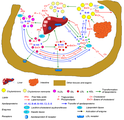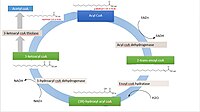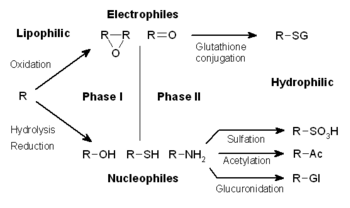Liver function
The liver has a large number of functions aimed at maintaining homeostasis.
Metabolic functions[edit | edit source]
They include the biosynthesis of the body's own compounds, their storage, conversion and breakdown into molecules capable of excretion.
Carbohydrate metabolism[edit | edit source]
One of the most important functions of the liver is to maintain a constant concentration of glucose in the blood. In hepatocytes, glycogen is synthesized from glucose through the process of Glycogenesis during elevated glycemia. If the concentration of glucose in the blood is lower, glucose is released from glycogen stores using glycogenolysis. If there are no more glycogen stores in the cell, hepatocytes use other substrates to synthesize glucose:
- non-sugar substrates (glycerol, lactate and glucogenic amino acids – gluconeogenesis),
- monosaccharides (fructose and galactose),
- non-sugar substrates (amino acids).
Regulation of gluconeogenesis in the liver is controlled by hormones. Cortisol, glucagon and adrenaline activate it, while insulin inhibits it. Hepatocytes have insulin-independent transporters built into the membrane , at the same time they contain the enzyme glucose-6-phosphatase (muscles do not have this enzyme), which enables the release of glucose from glucose-6-phosphate. Metabolism ofu fructose and galactose also occurs here.
Amino acid and protein metabolism[edit | edit source]
Deamination and transamination of amino acids take place in the liver . During deamination the body gets rid of energy-unusable nitrogen. Therefore, urea, is synthesized in the liver , which is then excreted from the body in urine. The carbon skeletons of amino acids are used to synthesize glucose and fatty acids. In addition to urea, the liver synthesizes most blood plasma proteins, coagulation factors and is the main site of purin nucleotide synthesis.
Lipid metabolism[edit | edit source]
Fatty acids are transported to the liver by means of chylomics or by the formation of an albumin-fatty acid complex. Their β-oxidationtakes place here, withincreased formation of acetyl-CoA followed by ketogenesis. The liver is unable to metabolize the resulting ketone bodies, their utilization takes place in extrahepatic tissues. Other important processes include the synthesis of fatty acids, the synthesis of triacylglycerols and phospholipids. These are transported using lipoprotein particles to other tissues of the body. Cholesterol, is synthesized in the liver , and at the same time it is converted into bile acids.
Thermoregulation function[edit | edit source]
The liver produces a large amount of heat, which is related to its high metabolic activity.
Storage function[edit | edit source]
The liver can serve as a blood reservoir. Blood can be expelled from them under certain circumstances (e.g. in case of circulatory hypovolemia). The following are also stored in the liver:
- glucose (in the form of glycogen),
- metals: iron (bound in the form of ferritin), copper, cobalt (in the form of B12)
- Vitamins: vitamin A – supply for 10 months, vitamin D – 2–3 months, vitamin B12 – several years.[1]
Exclusion function[edit | edit source]
For example steroid hormones and bilirubin are inactivated in the liver by transformation reactions and converted to more polar metabolites that can be excreted.
Secretion functions[edit | edit source]
The liver makes approximately 500–1000 ml[2] of bile per day.
Bile consists of::
- bile acids and their salts (used in lipid emulsification),,
- cholesterol,
- phospholipids (increase the solubilizing ability of bile acids),
- bilirubin (degradation product of heme),,
- protein a minerals.
Synthetic functions[edit | edit source]
Synthesis takes place in the liver:
- of glucose (gluconeogenesis) and glycogen (glycogenesis),
- ketolates,
- fatty acids, cholesterol, triacylglycerols and phospholipids,
- urea,
- plasmatic proteins,
- fibrinogen and coagulation factors,
- angiotenzinogen,
- somatomedin,
- VLDL and HDL type lipoproteins,
- erythropoietin – about 10% of the total production of erythropoietin occurs in the liver[1] (the rest in the kidneys).
Detoxification and defense functions[edit | edit source]
Microorganisms that have passed through the intestinal barrier or various toxic substances can reach the liver via the portal blood. Liver enzymes and phagocytic Kupffer cells prevent their penetration into the systemic circulation.
Enzymatic systems of the liver break down exogenous látky (xenobiotika) substances (xenobiotics), which include medicines, food additives, etc. The biotransformation of these substances takes place in two phases. In the first phase the substance is transformed by oxidation, hydroxylation, reduction or hydrolysis, in the second phase it is conjugated with other substances (synthesis), and then it is excreted in the urine.
Other functions[edit | edit source]
- Hematopoiesis in the fetal period.
- Participation in maintaining the acid-base balance of the organism.
- Influencing the function and effect of some hormones – inactivation if inzslin for example.
Links[edit | edit source]
External Links[edit | edit source]
Related articles[edit | edit source]
- Liver
- Biochemical examinations of the liver • Diagnostic imaging methods in the examination of the gallbladder and bile ducts
- Hepatomegaly • Hepatosplenomegaly • Sarcoidosis of liver • Liver Cysts and abscess • Liver Failure • Cirrhosis • Hepatitis • Liver tumors • Liver injuries • Portal hypertension
- Development of the liver and gallbladder
- Bile ducts • Gallbladder • Spleen • Kidney
References[edit | edit source]
Used literature[edit | edit source]
- ČIHÁK, Radomír. Anatomie. 3. edition. Grada Publishing, a.s., 2011. 287 pp. ISBN 9788024738178.
- KITTNAR, Otomar, et al. Lékařská fyziologie. 1. edition. Praha : Grada, 2011. 790 pp. ISBN 978-80-247-3068-4.
- KOOLMAN, Jan – RÖHM, Klaus-Heinrich. Barevný atlas biochemie. 1. edition. Praha : Grada, 2012. 512 pp. ISBN 978-80-247-2977-0.
- MYSLIVEČEK, Jaromír – TROJAN, Stanislav. Fyziologie do kapsy. Levou zadní edition. Praha : Triton, 2004. 466 pp. vol. 103. ISBN 80-7254-497-7.
- TROJAN, Stanislav – TROJAN, Stanislav, et al. Lékařská fyziologie. 4. edition. Praha : Grada, 2003. 772 pp. ISBN 80-247-0512-5.










